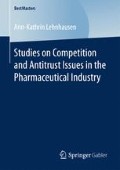Abstract
This publication studies whether actions in restraint of competition always harm consumers and if not, under what circumstances positive welfare effects for consumers emerge. Antitrust laws and regulatory provisions, which can vary significantly across countries, and the complexity of the pharmaceutical market structure influence the market exclusivity time of originator manufacturers. As innovators spend about a billion of revenues on average on the development of new compounds, patent protection grants them a 20-year period of market exclusivity to generate profits for covering innovation costs.
Access this chapter
Tax calculation will be finalised at checkout
Purchases are for personal use only
Author information
Authors and Affiliations
Corresponding author
Rights and permissions
Copyright information
© 2017 Springer Fachmedien Wiesbaden GmbH
About this chapter
Cite this chapter
Lehnhausen, AK. (2017). Conclusion. In: Studies on Competition and Antitrust Issues in the Pharmaceutical Industry. BestMasters. Springer Gabler, Wiesbaden. https://doi.org/10.1007/978-3-658-16551-2_5
Download citation
DOI: https://doi.org/10.1007/978-3-658-16551-2_5
Published:
Publisher Name: Springer Gabler, Wiesbaden
Print ISBN: 978-3-658-16550-5
Online ISBN: 978-3-658-16551-2
eBook Packages: Business and ManagementBusiness and Management (R0)

